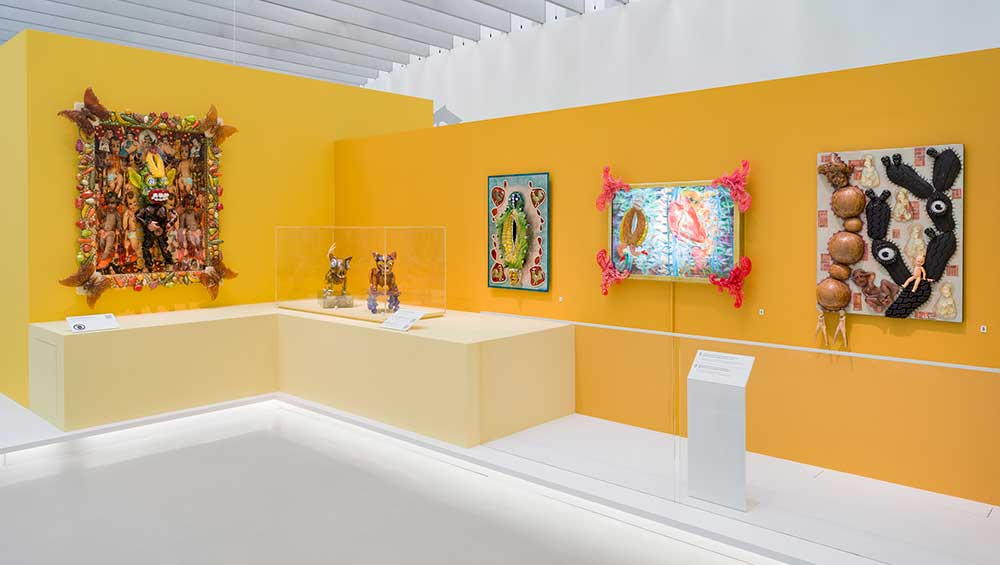
An array of eclectic sculptures from the Hybrid Dislocations grouping. From left to right: El secreto de Darwin (Darwin's Secret), Nueva Generación, Pork Belly Futures, Jerarquía (Pecking Order), Corazón Corriente (Running from the Heart), M'ezcalera al Cielo (M’stairs to the Sky). Photo courtesy Corning Museum of Glass.
Corning Museum of Glass, New York
18 May 2024 – 5 January 2025
by LILLY WEI
Entering the Corning Museum of Glass in upstate New York felt a bit like experiencing a sonic boom, except it is visual art and without a soundtrack. Or was there one? Collidoscope: De la Torre Brothers Retro-Perspective is a travelling survey of the works of the brothers Einar and Jamex de la Torre who have been collaborators since the 1990s. The 40 works in the exhibition occupy the museum like a kind of latter-day Reconquista, triumphantly wresting back the narrative of Mexican art and culture from (colonialist and other) outsiders. The title discloses the De la Torres’ game plan and is the first of many neologisms and portmanteau cobblings that are as much part of this exhibition as the images: the brothers’ comic, disingenuous wordplay – their puns and punchlines – are what we have come to expect from them. Humour, visual and verbal, lightens the De la Torres’s point of view and prevents the darkness from becoming too dark, too crushing, but, despite that, it is a pointed critique of conquest and continuing inequities and betrayals: it is the “complexities of the immigrant experience” that “propel our narratives and aesthetics”, Einar de la Torre said.
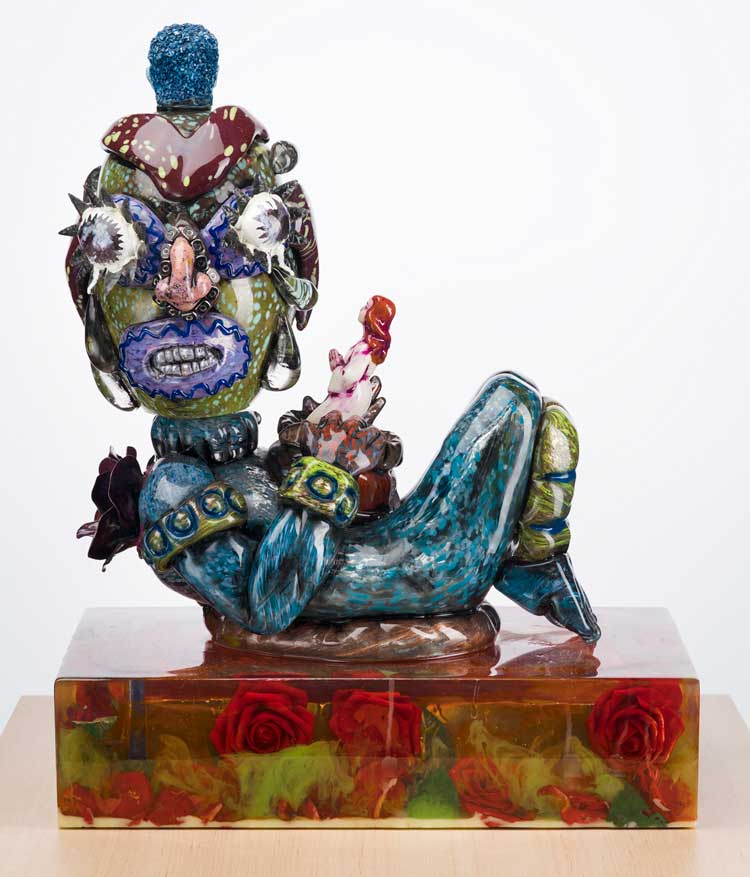
Chat with Chac, by Einar and Jamex de la Torre, 2021. Blown-glass, mixed-media sculpture, 19 x 23 in. Photo: Courtesy of Einar and Jamex de la Torre and Koplin Del Rio Gallery
This spirited display is indeed a collision, its kaleidoscopic array of images, materials and mediums sweeps together European old masters, modernist paintings and Mexican vernacular art into elaborate, provocative, ingenious concoctions that explore and comment on the tangled interconnections between Mexico, El Norte and beyond. The artists, born in Guadalajara, Mexico, are of Mexican and Danish descent, identifying as Mexican American. Master glass artisans as well as fine artists, they live and work between San Diego and Baja California, Mexico, and are deeply aware of the frequent troubles that plague the region on either side of the border. (Are we braced for mass deportations come November?)
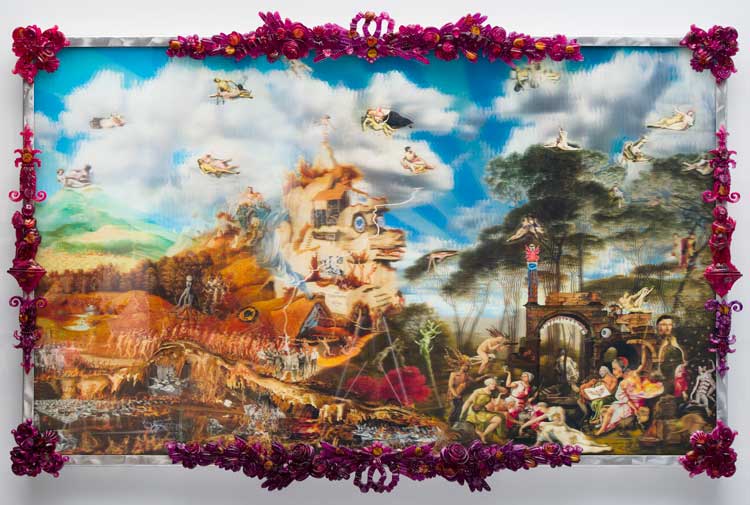
Sloth, by Einar and Jamex de la Torre, 2017. Archival lenticular print in LED Lightbox, 60 x 48 in. Photo: Courtesy of Einar and Jamex de la Torre and Koplin Del Rio Gallery.
Encompassing nearly three decades of their prolific production, Collidoscope fills the space with bombshells of colour from sparkling blown-glass sculptures bedecked with gewgaws that are both hand-made and mass-produced; no surface that can be embellished is not. The other half of the exhibition is on a series of gaudy, insanely configured, often large-scale lenticular prints, a genre associated with kitsch and tacky decors. In their hands, however, the optical feints that are the stock in trade of lenticulars have acquired new (literal and metaphoric) depth of meaning and composition, as kitsch and fine arts are scrambled together and all the better for it. While the extravagant installations for which the brothers are known – as well as huge public art projects – are not in this show, each object here, despite its size, contains its own irreverent multitude of references.
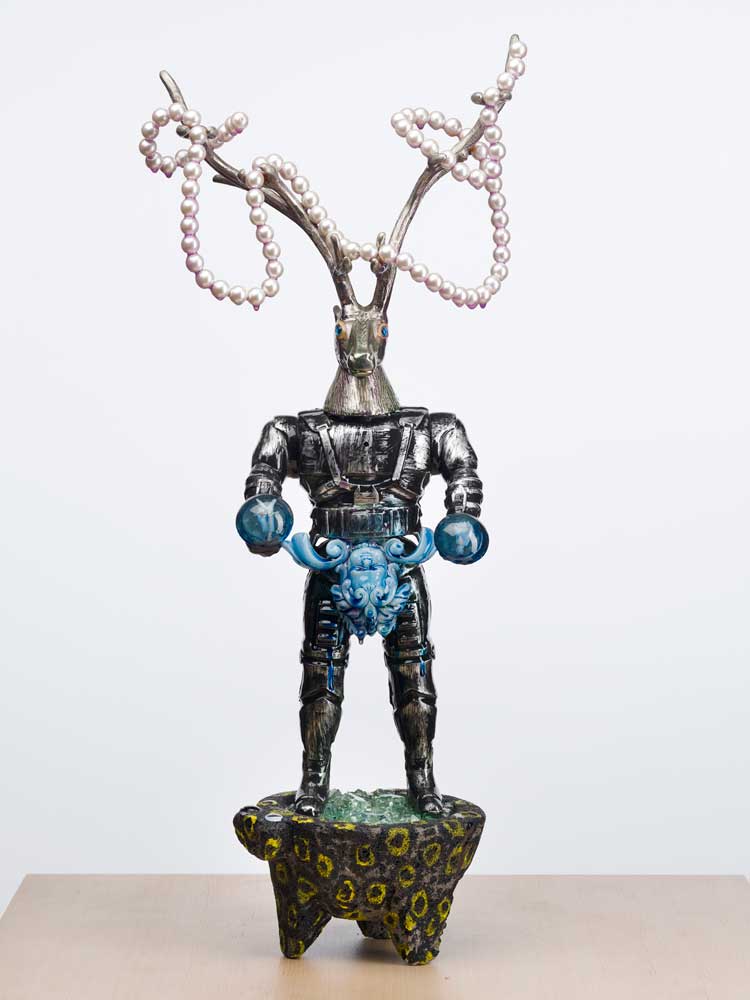
Yaki Transformer, by Einar and Jamex de la Torre, 2020. Mixed-media sculpture, 27 x 12 in. Photo: Courtesy of Koplin Del Rio Gallery.
The exhibition – a maximalist’s delight, a minimalist’s nightmare – is divided into several thematic sections that overlap somewhat and are essential to taming and clarifying the abundance of content. Like Retro-perspective, Retracollage, one of the show’s categories, is also a word freighted with meanings, from the layering and accumulation that is collage to the backward regard and direction of “retro” – including the negative connotation of retrograde, to a nod to the word “retrato”, Spanish for portrait. That’s a lot of inferences to toss around, conveyed by a (deceptively) appealing collection of small glittering works in a range of rainbow colours. Of blown glass and resin and arranged on an extended platform, they are all hybridised oddities from far-flung sources that include mythology, folklore, history and pop culture – there is one imposing figure (or it would be if it were bigger) called Yaki-Transformer (2020) that is a robot toy warrior with the elegant head of a deer, its antlers necklaced by a string of gleaming pearls.
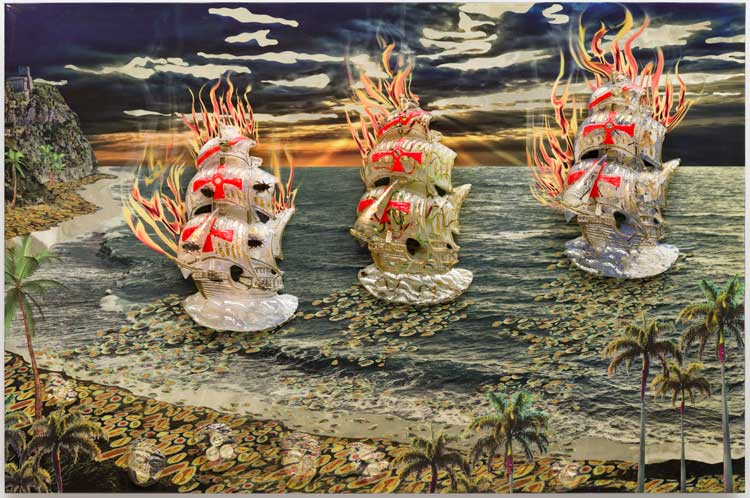
Quemando las Naves, by Einar and Jamex de la Torre, 2015. Archival lenticular print with resin castings on aluminium, 48 x 72 in. Photo: Courtesy of Einar and Jamex de la Torre and Koplin Del Rio Gallery.
Another section is aptly named Histerical Vignettes, and is mostly lenticulars, showing us what the de la Torres can do with the often-derided format as they mash-up historical events north and south, east and west, joining them together as (fake) news with (real) insight in their quest to reappraise, repossess and rewrite the script. One lenticular (among the least complicated, others have Putin, Marx, Godzilla, Barbie, Simon de Bolivar, hobnobbing together) shows Columbus’s three ships, the Nina, the Pinta and the Santa Maria, on fire. One interpretation of the picture, Quemando las Naves (Burning the Ships) (2015), sees it as the destruction of slave ships, but it might also be read as alternative history, Columbus’s voyage thwarted, his ships destroyed, the course of history skewed, skewered (although Isabella and Ferdinand, los Reyes Catolicos, most likely would have just sent out another expedition). Still, who knows?
The last section is called Systems and Cycles, which also connects disparate tableaux, its subject the sciences, nature and the spirallings of history. They are the cacophonous heart of the show, an eye-filling series of spectacles to decode, their three-dimensional optical feints rippling the surface as they unleash a volley of critiques that focus on what occurs at the border, what flows in and out, and it is much more than tacos and enchiladas, although food images play a role.
.jpg)
Oxymodern (Aztec Calendar) by Einar and Jamex de la Torre, 2002. Blown-glass, mixed-media wall installation, 120 x 120 x 12 in. Photo credit: Courtesy of the Cheech Marin Collection and Riverside Art Museum.
There are several magnificent blown-glass, jewel-toned tondo-like wall pieces that suggest East Asian mandalas as well as ancient Aztec calendars. One striking example is Oxymodern (Aztec Calendar) (2002) that depicts time as something to be consumed, its images recounting a tale about a domino game and a banquet, its gorgeousness at odds with the objects depicted, such as the grimacing masks and the anatomically correct hearts strewn around the circumference, which makes me think of the sacrificial rites of the Aztecs in which ripped out hearts abound, so it is conjectured.
The De la Torres seem to be having a ball with this, despite the traumatic subject matter, weaponising the humour, but also considering it reparative. Eye-riveting, flamboyant, crowd-pleasing, they make you chuckle at the same time they make you think and rethink the history south of the border from 1492 onward.